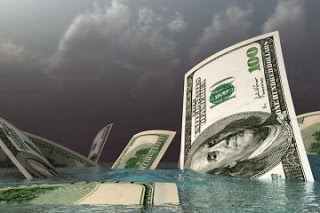Mac Slavo
SHTFPlan
Reuters’ Emily Flitter asks in a recent column What is Plan B if China dumps its U.S. debt?
It is worth asking about U.S. officials’ Plan B just in case one day relations take a surprise turn for the worse and Beijing dumps its holdings of U.S. treasuries.
China is officially the United States’ biggest foreign creditor, with roughly $900 billion in Treasury holdings — or over $1 trillion with Hong Kong’s holdings included.
That means it could do severe damage to U.S. debt markets if it suddenly started selling large amounts.
This is not a “just in case” scenario. China has already been taking steps to curb their US Treasury purchases, lowering their U.S. debt holdings from $929 billion to $896 billion between November of 2009 and 2010 (Hong Kong’s year over year holdings are down as well). Chinese President Hu Jintao made it clear where the Chinese stand with regards to the US dollar of the future calling the current dollar-led global monetary system a “product of the past.” While this may not necessarily mean the Chinese will one day, all of a sudden, halt all purchases of US debt, it is certainly reason for concern to those hoping to maintain a strong and stable U.S. currency. Our major foreign creditor is reducing their exposure – that means something, or at least it should. The US dollar, as it has for the last 100 years, will continue to weaken over time compared to other major currencies, and our dollars will buy fewer and fewer goods as a result. The nation’s fiscal problems will see to it that the depreciation of the dollar accelerates over time.
The slow collapse of the dollar, in our view, would be the best-case scenario, but there is still the very real possibility that China completely pulls the plug and kills the patient. Ms. Flitter writes:
To be sure, the idea that China would suddenly sell its U.S. debt holdings is almost unimaginable to some.
After all, any weakening in the U.S. debt markets and the resulting global markets turmoil, including likely weakness in the dollar, would bounce back on China and could hurt its economy badly, especially as the United States is such a huge Chinese export market.
It is only unimaginable to some because they don’t believe it can happen here. But it can happen here – it must. The lead stories during this economic recession/depression have been about real estate, jobs, and GDP. The real story is none of those. Although it has yet to become the mainstream talking point , the real crisis facing America is a sovereign debt crisis. We have too much debt, and that’s going to get cleared out of the system one way or the other.
Any number of reasons, some of which Ms. Flitter mentions in her article, could be used as justification by China to stop the purchase of U.S. debt. Trade and resource disputes, Taiwan, or the final push to bring America to it’s knees. Sure, the Chinese economy and its people will hurt for a few years, but it would be a small price to pay by a communist Chinese government to see the world’s major super power be marginalized or perhaps even completely obliterated.
Make no mistake. The Chinese are at war. These events are not simple one or two dimensional short-term manipulations. The playing field is a grand chessboard and the Chinese have been positioning their pieces for decades. An attack on the King is imminent.
Ms. Flitter suggests several plans (packaging them into what she refers to as ‘Plan B’) to deal with the attack once it begins and be assured it will. You can be certain of it.
In an earlier report we detailed that the Pentagon and Military are Actively War Gaming ‘Large Scale Economic Breakdown’ and ‘Civil Unrest’ scenarios, going so far as to send military specialists to the floors of our stock exchanges to learn more about how a financial attack on our system would occur and to develop response plans if and when it does.
Plan B
Banks could be called on to increase their holdings of treasuries, and as a last resort, the Federal Reserve could also be called on to fill the gap, though this could risk turning any dollar weakness into a slump.
Plan B is already in effect, as evidenced by the monetization of US debt by the Federal Reserve. It started in 2008 and continues to this day, with the most recent round being some $600 billion dollars (officially). In case you haven’t heard, the privately held (by major banking institutions) Federal Reserve is the largest buyer of US debt, having surpassed China as of November 2010.
Given that we have been engaging in Quantitative Easing for quite some time, and the US dollar continues to lose strength and status, we suggest that Plan B has already failed.
RELATED ARTICLE:
A ‘new phase of globalization’ Is Taking Shape in Beijing



Be the first to comment on "Saving a Doomed Dollar: Plans B, C, D, and E"